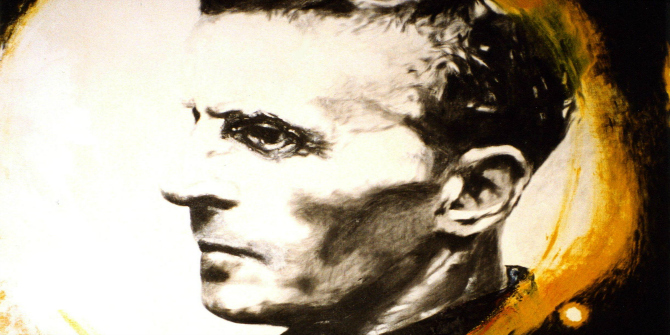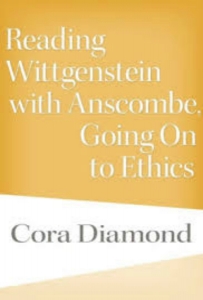In Reading Wittgenstein with Anscombe: Going on to Ethics, Cora Diamond makes the case for (re)reading Ludwig Wittgenstein alongside the philosopher G.E.M. Anscombe as a means to see Wittgenstein’s thought anew and gain fresh perspectives on contemporary debates. Enabling a discussion of ethics that applies Wittgenstein’s logical considerations to conversations on justice, this book is a wonderful tribute to one of Wittgenstein’s most brilliant students and an admirable history of philosophy done philosophically, writes Adam Woods.
Reading Wittgenstein with Anscombe: Going on to Ethics. Cora Diamond. Harvard University Press. 2019.
It has been just over a century since the completion of Ludwig Wittgenstein’s first masterpiece, the Tractatus Logico-Philosophicus, and still debate surrounds not only the genuine accomplishments of his work, but what exactly it was that he was trying to achieve. This has complicated the understanding of Wittgenstein’s position in the history of philosophy, which has undergone a number of permutations and led to various schools of thought claiming him as their own. We have seen Wittgenstein as a relativist, a proto-positivist, a Kantian, ‘a latter-day Hume’; and we have seen the Tractatus as offering a theoretical account of language that resolves all philosophical problems in essentials, as a simultaneously scientific and mystical text, as a positivist’s bible and as a work whose culminating sentence issues a rebuke to all of these doctrines. Wittgenstein aimed to revolutionise philosophical thinking by moving beyond uses of philosophical language in which recurring problems present themselves. He sought to transform philosophy into an activity that begins and ends in response to the kinds of confusion that arise when a person hasn’t given significant meaning to some signs in their propositions. One of his focal concerns is found at 4.116 of the Tractatus, where he declares: ‘everything that can be said can be said clearly’. That his position is nebulous and shrouded in ambiguity is no doubt one of the great ironies of intellectual history.
Part of the difficulty is due in no small part to a variety of framing assumptions that readers bring to the text itself, which confuse the understanding of Tractarian questions such as how a proposition hangs together, how thought and reality are related and how this relates to truth. But perhaps one final irony can be derived from Wittgenstein’s own style – at times telegraphic, synoptic, provocative and, in places, cryptic – which might be partly generative of these disputes. While the Tractatus is a highly organised text consisting of a tightly knit pattern of ratiocination, the apothegms that comprise it have been the source of enormous exegetical commentary surrounding whether Wittgenstein should be read ‘resolutely’ or not.
Cora Diamond is perhaps the paragon of the resolute reading and her new book sees her engaging with the thought of G.E.M. Anscombe, one of the early readers whose work is now deemed prototypical of the Orthodox school by this relatively new caucus. And while they ostensibly belong to two opposing camps, Diamond begins by making a case for the reintroduction of Anscombean questions, with the promise that through these we may come to see Wittgenstein’s work anew and gain fresh perspectives in contemporary debates. This allows Diamond to take a new angle on a number of disparate topics while retaining a thematic unity contained in the thought that, through reading both Wittgenstein and Anscombe, we can see them thinking about thinking, seeking to understand the unclarities and confusions that accompany our lives in language and thereby formulate effective responses to thought that has been interrupted by perplexity.
In her first section, Diamond exemplifies what Myles Burnyeat called the ‘history of philosophy done philosophically’: a practice of philosophical criticism aimed at accounting for the historical context of Wittgenstein’s own motivations to come to grips with the philosophical problems with which he was concerned (4). In doing philosophy in this way, both historically and against the grain of shared contemporary preconceptions, we find Anscombe and Diamond fighting on more than one front, effecting a dual movement that aims at working through the past to reposition the way our contemporary assumptions may shape what we take to be the Tractatus’ message.
 Image Credit: Painting of Ludwig Wittgenstein by Christiaan Tonnis (Christiaan Tonnis CC BY SA 2.0)
Image Credit: Painting of Ludwig Wittgenstein by Christiaan Tonnis (Christiaan Tonnis CC BY SA 2.0)
At issue here is the importance of the philosophers Gottlob Frege and Bertrand Russell and a debate over who holds the strongest claim to be Wittgenstein’s most significant intellectual progenitor. For Anscombe, it is the neglect of Frege and over-emphasis on Russell that obfuscates our understanding of Wittgenstein’s philosophy (98). Thus, her presentation of Wittgenstein’s so-called ‘picture theory’ points us to fundamental connections between his thought and that of Frege, thereby exemplifying the kind of philosophical activity to which the Tractatus was meant to inaugurate. Diamond broadly agrees with this ‘unRussellian’ starting point. But the source of her disagreement with Anscombe is the character of Wittgenstein’s unRussellianism. This might suggest that the difference between them is one of emphasis, but it ramifies into separate understandings of Wittgenstein’s conception of propositional sense and his use of the context principle. Extracted from this is a very different idea of where Wittgenstein ends up. Anscombe argues that he retains a Fregean conception of sense, albeit with ‘different theses’ about it (8); for Diamond, Wittgenstein ends up with a conception that is both unFregean and unRussellian and completely his own (23).
What Wittgenstein means by sense is linked to the analogy of propositions with pictures and their representing possible ways things can be in the world. Propositions are analogous with pictures to the extent that we can use them to say that this is how things stand and we can also use the very same picture to claim the inverse. Contained within this notion is the dual possibility of being used in two opposite ways to make two opposite claims: ‘this is how things are’, and, conversely, ‘this is how things aren’t’. A proposition derives its sense from its possibility of standing-for-something and the representational feature of these claims rests on the connection between the signs of the proposition and their relation to a person or object in reality.
This paves the way for the next two chapters in which Diamond explores Anscombe’s work on propositions and ‘What Can Only Be True’. Much of the discussion takes its leave from the two chapters in Anscombe’s Introduction to Wittgenstein’s Tractatus that deal with negation understood as the reversal of the logical directionality of sense. The possibility of propositional bivalence is what the picture theory is designed to account for, and Anscombe’s criticism of it is that it rules out the possibility of propositions that do not have a significant negation that can nevertheless be true. This is worked out in Anscombe’s willingness to speak of propositions that lack an intelligible negation and therefore escape the picture theory, but nevertheless hold true. Here we see that the negation of a philosophical truth represents a literally unthinkable scenario as logical truths do not have negations that we can understand. This provides the crucial context for Diamond going onto ethics.
As Anscombe describes the matter:
there is a strong impression made by the end of Tractatus, as if Wittgenstein saw the world looking at him with a face; logic helped to reveal that face […] the world thought of, not as how things are, how as however they are – seen as a whole – is a matter of logic; thought of as my life, it is a matter of ethics.
To this, we might add Wittgenstein’s thought that ‘ethics does not treat of the world. Ethics must be a condition of the world, like logic.’ But this is another vexed topic in the commentary and a key issue is accounting for how ethics can continue in the wake of a philosopher who once said that there are no ethical propositions.
Diamond’s engagement with Anscombe provides a compelling avenue in this discussion. She shows that simply facing the world confronts us with ethical questions of how to comport ourselves in relation to it. Ethics, like logic, is something that we live by way of. It is not a distinct sub-field of philosophy, but something that imbues all of our thought and action in the world. In her final section, we see her interpose Wittgensteinian thought into the debate between the philosophers David Wiggins and Bernard Williams that gathers around meta-ethical commitment to a form of relativism on Williams’s part and the refutation of this by Wiggins in favour of a dogged insistence on the particular case.
This is explored by Diamond under the heading of ‘thinkables-with-no-alternatives’ (232): that is, propositions that have no intelligible negation. Through the innovative use of ‘solo propositions’ (270), Diamond introduces an ethical picture of what it means to think correctly. We see that there are not two possible responses to slavery: ‘slavery is bad’ and ‘slavery is justifiable because it is the backbone of the Southern economy’. Those who opposed the anti-slavery movement in the nineteenth century found themselves in a nonsensical position in which they were unable to think a just thought (305). They exempted themselves from the form of life constitutive of moral rationality and produced a failure of thought that rendered them morally unintelligible. In getting this into view, it becomes clear that there is only one genuine possibility for thought on this particular question.
Another innovation is the use of what Diamond calls ‘path-indicators and path-blockers’ (259). This is deeply connected to the Wittgensteinian concern with combating thought that has become confused and gone astray, interweaved throughout the book. Path-indicators show how we might go on in our thinking free of confusion; path-blockers can be used as philosophical responses to confusion that erect road signs of ‘no entry’ or ‘road closed ahead’ to put the stoppers on wayward thought. This is a novel way to combat what Wittgenstein calls at §131 in the Philosophical Investigations ‘ineptness or emptiness in our assertions’. These tools provide a persuasive backstory about why a path is open or blocked to get thinking back on track by showing that the connections our propositions make are tied to the kind of use they are meant to have (260). These add a preparatory level to Wiggins’s account of moral thought, contributing another consideration that Diamond sees as crucial for getting the character of the debate into view (268).
What we find at stake are questions about the aims and character of philosophical clarification, the ethical implications of which work to counteract the common assumption that Wittgenstein’s work rules ethical thought out ab initio. And what Diamond shows us here, through Anscombe’s particular brand of Wittgenstein-inflected Aristotelianism, is how logic and ethics are coeval. This shouldn’t, however, be taken to illuminate paths solely within Wittgenstein scholarship. Diamond contextualises her discussion through the Declaration of Independence and nineteenth-century slavery debates, and in doing so indicates the availability of Wittgenstein’s thought to interdisciplinary application across historical, political and juridical lines (234).
Stanley Cavell has suggested that the mark of a text’s worth can be measured by the texts that spring up in response to it. That Anscombe has served as a sounding post for some of the most resonant work that Diamond has produced might serve as an initial indicator of Anscombe’s lasting importance to the study of Wittgenstein’s thought. She is someone to struggle both with and against, and Diamond’s book reveals the promise that such an engagement contains to renew contemporary debates in epistemology surrounding truth and in ethics that apply Wittgenstein’s logical considerations to conversations of justice. What Diamond offers here is a wonderful tribute to one of Wittgenstein’s most brilliant students: a work of the history of philosophy done philosophically, in which Anscombe figures as interlocutor and inspiration to a contextual repositioning of the Tractatus and a new account of Wittgenstein’s inheritance from Frege and Russell. But the real payoff comes in the ethical part of the book that shows the practical consequences of taking up Anscombean questions in this way and the distinct and original picture it provides of the nature and character of Wittgensteinian philosophy.
Adam Woods is a PhD student at the University of East Anglia. His research focuses on applying Wittgenstein’s philosophy to a second-personal consideration of relationality. He doesn’t tweet from @adamianwoods.
Note: This review gives the views of the author, and not the position of the LSE Review of Books blog, or of the London School of Economics.


 Find this book:
Find this book: 



3 Comments